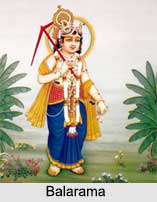 Lord Balarama is believed to be Lord Krishna"s second body who is the elder brother of Lord Krishna. In Hinduism and especially in Vaishnava traditions he is acknowledged as the manifestations of "Shesha", the divine serpent on whom Lord Vishnu rests. He is the source of the entire spiritual world and is the "adi-guru", the original spiritual master.
Lord Balarama is believed to be Lord Krishna"s second body who is the elder brother of Lord Krishna. In Hinduism and especially in Vaishnava traditions he is acknowledged as the manifestations of "Shesha", the divine serpent on whom Lord Vishnu rests. He is the source of the entire spiritual world and is the "adi-guru", the original spiritual master.
Legends of Lord Balarama
Lord Balarama is particularly significant in the Jagannath tradition, as one of the triad deities. He is also known as Baladeva, Balabhadra, Haladhara and Halayudha. He has strong relationships with farming and farmers. Most legends and texts consider him as the manifestations of "Shesha", the divine serpent of Lord Vishnu. "Gitagovinda" of Jayadeva explains him as the eighth avatar of Lord Vishnu. In Jainism, he is known as Baladeva and has been a historically significant farmer-related deity.
He is being classified in the "Vyuha" avatar where in "Shesha" is part of. He was the son of Vasudeva. When Balarama was conceived his origin was moved from Devaki`s womb into the womb of Rohini. He grew up with his younger brother Krishna in the household of Yashoda and Nanda. One day, Nanda requested the attendance of Sage Gargamuni to name the newborn Krishna and Balarama. When the Garga arrived, Nanda received him well. Gargamuni then reminded Nanda that Kansa was looking for the son of Devaki and if he performed the ceremony in affluence then it would come to his notice. Nanda therefore asked Garga to perform the ceremony in top secret. Balarama killed the asura Dhenuka sent by Kansa as well as Pralamba and Mushtika wrestlers sent by Kansa.
Iconography of Balarama
Balarama is depicted as light skinned. His weapons are the plough and the "gada". The plough is generally called "Balachita". His hair is tied in a topknot and he wears earrings, bracelets and armlets and is known for his strength.
Balarama in Kurukshetra war of Mahabharata
Balarama taught Duryodhana and Bhima the art of fighting with a mace. He went for a pilgrimage with his nephew Pradyumna and other Yadavas during the battle and returned on the last day. When Bhima defeated Duryodhana, Balarama threatened to kill Bhima.
Death of Balarama
Bhagavata Purana describes that after Balarama took part in the battle causing the devastation of the remainder of the Yadu dynasty; he sat down in a meditative state and departed from this world. The local people of Veraval believe that in the cave near the temple place, the white snake that came out of Balarama`s mouth got into that cave and went back to Patala Loka.
Temples of Balarama
Six major Balarama temples mentioned in the Puranas are "Unchagaon", "Aring", "Ram Ghat", "Baldeo", "Nari" and "Talvan". Others are Jagannath temples of Odisha and Jharkhand, Baladevjew Temple, Ananta Vasudeva Temple, Revti Baladevji Mandir in Gujarat, Shri Daau Ji Mandir in Haryana, Shri Dauji Mandir in Mainpuri and Mazhoor Balarama Temple in Kerala.



















